Fabrication and Tribological Performance of Self-Lubricating Porous Materials and Composites: A Review
Abstract
:1. Introduction
2. Fabrication of Porous Materials
3. Designing the Criteria and Lubrication Mechanism for Porous Self-Lubricating Composites
3.1. Polymer Matrix Porous Composites
3.2. Porous Metal and Ceramic Matrix Self-Lubricating Composites
4. Conclusions
Author Contributions
Funding
Institutional Review Board Statement
Informed Consent Statement
Data Availability Statement
Conflicts of Interest
References
- Davis, M.E. Ordered porous materials for emerging applications. Nature 2002, 417, 813–821. [Google Scholar] [CrossRef] [PubMed]
- Ahuja, G.; Pathak, K. Porous carriers for controlled/modulated drug delivery. Indian J. Pharm. Sci. 2009, 71, 599. [Google Scholar] [CrossRef] [PubMed]
- Wu, J.; Xu, F.; Li, S.; Ma, P.; Zhang, X.; Liu, Q.; Fu, R.; Wu, D. Porous polymers as multifunctional material platforms toward task-specific applications. Adv. Mater. 2019, 31, 1802922. [Google Scholar] [CrossRef] [PubMed]
- Nakajima, H. Fabrication, properties and application of porous metals with directional pores. Prog. Mater. Sci. 2007, 52, 1091–1173. [Google Scholar] [CrossRef]
- Chen, Y.; Wang, N.; Ola, O.; Xia, Y.; Zhu, Y. Porous ceramics: Light in weight but heavy in energy and environment technologies. Mater. Sci. Eng. R Rep. 2021, 143, 100589. [Google Scholar] [CrossRef]
- Dabrowski, B.; Kaminski, J.; Swieszkowski, W.; Kurzydlowski, K.J. Porous titanium scaffolds for biomedical applications: Corrosion resistance and structure investigation. In Proceedings of Materials Science Forum; Trans Tech Publications Ltd.: Bäch, Switzerland, 2011; pp. 41–46. [Google Scholar]
- Jodati, H.; Yılmaz, B.; Evis, Z. A review of bioceramic porous scaffolds for hard tissue applications: Effects of structural features. Ceram. Int. 2020, 46, 15725–15739. [Google Scholar] [CrossRef]
- Rashidi, S.; Esfahani, J.A.; Rashidi, A. A review on the applications of porous materials in solar energy systems. Renew. Sustain. Energy Rev. 2017, 73, 1198–1210. [Google Scholar] [CrossRef]
- Indian Institute of Technology Kharagpur. Vacuum Sintering of Self-Lubricating Bronze Bearings. Ph.D. Thesis, Indian Institute of Technology Kharagpur, Kharagpur, India, 1981.
- Pound, M.; Rowley, A.; Elliott, J. Aspects of the Volume Production of Green Porous Bearing Compacts. Powder Metall. 1960, 3, 129–149. [Google Scholar] [CrossRef]
- Xu, X.; Shu, X.; Pei, Q.; Qin, H.; Guo, R.; Wang, X.; Wang, Q. Effects of porosity on the tribological and mechanical properties of oil-impregnated polyimide. Tribol. Int. 2022, 170, 107502. [Google Scholar] [CrossRef]
- Zhang, D.; Wang, T.; Wang, Q.; Wang, C. Selectively enhanced oil retention of porous polyimide bearing materials by direct chemical modification. J. Appl. Polym. Sci. 2017, 134, 45106. [Google Scholar] [CrossRef]
- Li, X.; Olofsson, U. A study on friction and wear reduction due to porosity in powder metallurgic gear materials. Tribol. Int. 2017, 110, 86–95. [Google Scholar] [CrossRef]
- Zhang, G.; Tong, B.; Zhang, X.; Wang, T.; Yin, Y. Thermo-hydrodynamic modeling and analysis for circular bilayer self-lubricating bearing. J. Braz. Soc. Mech. Sci. Eng. 2020, 42, 18. [Google Scholar] [CrossRef]
- Wang, H.; Wang, G.; Zhang, S.; Yang, S.; Zhu, Y. Tribological performances on porous polyphenylene sulfide self-lubricating composites with super wear resistance. J. Thermoplast. Compos. Mater. 2014, 27, 82–92. [Google Scholar] [CrossRef]
- Mu, B.; Yu, Z.; Cui, J.; Yan, W.; He, H.; Wang, X.; Guo, J.; Tian, L.; Yang, B.; Cui, J. Tribological Properties of Oil-Containing Polyimide Aerogels as a New Type of Porous Self-Lubricating Material. Ind. Eng. Chem. Res. 2022, 61, 14222–14231. [Google Scholar] [CrossRef]
- Lei, Y.; Du, J.; Pang, X.; Wang, H.; Yang, H.; Jiang, J. Tribological properties and lubrication mechanism of in situ graphene-nickel matrix composite impregnated with lubricating oil. Mater. Res. Express 2018, 5, 056512. [Google Scholar] [CrossRef]
- Wang, J.; Zhao, H.; Huang, W.; Wang, X. Investigation of porous polyimide lubricant retainers to improve the performance of rolling bearings under conditions of starved lubrication. Wear 2017, 380, 52–58. [Google Scholar] [CrossRef]
- Shang, Y.; Zhao, Y.; Liu, Y.; Zhu, Y.; Jiang, Z.; Zhang, H. The effect of micron-graphite particle size on the mechanical and tribological properties of PEEK composites. High Perform. Polym. 2018, 30, 153–160. [Google Scholar] [CrossRef]
- Wang, Q.; Wang, Y.; Wang, H.; Fan, N.; Wang, M.; Liu, H.; Yan, F. Comparative study of the effects of nano-sized and micro-sized CF and PTFE on the thermal and tribological properties of PEEK composites. Polym. Adv. Technol. 2018, 29, 896–905. [Google Scholar] [CrossRef]
- Zhu, Y.; Wang, G.; Wang, H.; Zhang, S.; Yang, S. Tribological properties of porous PPS/PTFE composite filled with mesopore titanium oxide whisker. J. Appl. Polym. Sci. 2013, 129, 2321–2327. [Google Scholar] [CrossRef]
- Bora, M.Ö.; Coban, O.; Avcu, E.; Fidan, S.; Sınmazçelik, T. The effect of TiO2 filler content on the mechanical, thermal, and tribological properties of TiO2/PPS composites. Polym. Compos. 2013, 34, 1591–1599. [Google Scholar] [CrossRef]
- Wang, C.; Zhang, D.; Wang, Q.; Ruan, H.; Wang, T. Effect of Porosity on the Friction Properties of Porous Polyimide Impregnated with Poly-α-Olefin in Different Lubrication Regimes. Tribol. Lett. 2020, 68, 102. [Google Scholar] [CrossRef]
- Ruan, H.; Zhang, Y.; Li, S.; Yang, L.; Wang, C.; Wang, T.; Wang, Q. Effect of temperature on the friction and wear performance of porous oil-containing polyimide. Tribol. Int. 2021, 157, 106891. [Google Scholar] [CrossRef]
- Ye, J.; Li, J.; Qing, T.; Huang, H.; Zhou, N. Effects of surface pore size on the tribological properties of oil-impregnated porous polyimide material. Wear 2021, 484, 204042. [Google Scholar] [CrossRef]
- Zalaznik, M.; Kalin, M.; Novak, S.; Jakša, G. Effect of the type, size and concentration of solid lubricants on the tribological properties of the polymer PEEK. Wear 2016, 364, 31–39. [Google Scholar] [CrossRef]
- Huang, X.; Wu, J.; Lu, X.; Feng, X.; Shi, Y. Tribological properties of porous PEEK composites containing ionic liquid under dry friction condition. Lubricants 2017, 5, 19. [Google Scholar] [CrossRef]
- Senatov, F.S.; Niaza, K.V.; Zadorozhnyy, M.Y.; Maksimkin, A.V.; Kaloshkin, S.D.; Estrin, Y.Z. Mechanical properties and shape memory effect of 3D-printed PLA-based porous scaffolds. J. Mech. Behav. Biomed. Mater. 2016, 57, 139–148. [Google Scholar] [CrossRef] [PubMed]
- Chen, Q.; Cao, P.F.; Advincula, R.C. Mechanically robust, ultraelastic hierarchical foam with tunable properties via 3D printing. Adv. Funct. Mater. 2018, 28, 1800631. [Google Scholar] [CrossRef]
- Wei, P.; Leng, H.; Chen, Q.; Advincula, R.C.; Pentzer, E.B. Reprocessable 3D-printed conductive elastomeric composite foams for strain and gas sensing. ACS Appl. Polym. Mater. 2019, 1, 885–892. [Google Scholar] [CrossRef]
- Mu, X.; Bertron, T.; Dunn, C.; Qiao, H.; Wu, J.; Zhao, Z.; Saldana, C.; Qi, H.J. Porous polymeric materials by 3D printing of photocurable resin. Mater. Horiz. 2017, 4, 442–449. [Google Scholar] [CrossRef]
- Sinha, A.; Farhat, Z. Effect of surface porosity on tribological properties of sintered pure Al and Al 6061. Mater. Sci. Appl. 2015, 6, 549. [Google Scholar] [CrossRef]
- Kovalčíková, A.; Balko, J.; Balázsi, C.; Hvizdoš, P.; Dusza, J. Influence of hBN content on mechanical and tribological properties of Si3N4/BN ceramic composites. J. Eur. Ceram. Soc. 2014, 34, 3319–3328. [Google Scholar] [CrossRef]
- Hvizdoš, P.; Dusza, J.; Balázsi, C. Tribological properties of Si3N4–graphene nanocomposites. J. Eur. Ceram. Soc. 2013, 33, 2359–2364. [Google Scholar] [CrossRef]
- Xiao, G.; Zhao, B.; Ding, W. Mechanical and tribological properties of porous metallic CBN composites reinforced by graphene nanoparticles. Int. J. Adv. Manuf. Technol. 2021, 114, 397–405. [Google Scholar] [CrossRef]
- Manoj, A.; Kasar, A.K.; Menezes, P.L. Tribocorrosion of Porous Titanium Used in Biomedical Applications. J. Bio-Tribo-Corros. 2019, 5, 3. [Google Scholar] [CrossRef]
- Zhao, X.; Sun, H.; Lan, L.; Huang, J.; Zhang, H.; Wang, Y. Pore structures of high-porosity NiTi alloys made from elemental powders with NaCl temporary space-holders. Mater. Lett. 2009, 63, 2402–2404. [Google Scholar] [CrossRef]
- Wen, C.; Mabuchi, M.; Yamada, Y.; Shimojima, K.; Chino, Y.; Asahina, T. Processing of biocompatible porous Ti and Mg. Scr. Mater. 2001, 45, 1147–1153. [Google Scholar] [CrossRef]
- Andersen, O.; Waag, U.; Schneider, L.; Stephani, G.; Kieback, B. Novel metallic hollow sphere structures. Adv. Eng. Mater. 2000, 2, 192–195. [Google Scholar] [CrossRef]
- Aşık, E.E.; Bor, Ş. Fatigue behavior of Ti–6Al–4V foams processed by magnesium space holder technique. Mater. Sci. Eng. A 2015, 621, 157–165. [Google Scholar] [CrossRef]
- Zhao, J.; Wang, G.; Zhang, A.; Zhao, G.; Park, C.B. Nanocellular TPU composite foams achieved by stretch-assisted microcellular foaming with low-pressure gaseous CO2 as blowing agent. J. CO2 Util. 2021, 53, 101708. [Google Scholar] [CrossRef]
- Grassberger, L.; Koch, K.; Oberhoffer, R.; Müller, A.; Klemmer, H.F.; Strey, R. Blowing agent free generation of nanoporous poly (methylmethacrylate) materials. Colloid Polym. Sci. 2017, 295, 379–389. [Google Scholar] [CrossRef]
- Jee, C.; Guo, Z.; Evans, J.; Özgüven, N. Preparation of high porosity metal foams. Metall. Mater. Trans. B 2000, 31, 1345–1352. [Google Scholar] [CrossRef]
- Li, M.; Luo, X.; Zhang, G.; Xie, Z.; Zhao, L.; Jin, H. Effect of blowing-agent addition on the structure and properties of magnesia porous material. Refract. Ind. Ceram. 2017, 58, 60–64. [Google Scholar] [CrossRef]
- Yang, C.; Jiang, P.; Qin, H.; Wang, X.; Wang, Q. 3D printing of porous polyimide for high-performance oil impregnated self-lubricating. Tribol. Int. 2021, 160, 107009. [Google Scholar] [CrossRef]
- Heinl, P.; Müller, L.; Körner, C.; Singer, R.F.; Müller, F.A. Cellular Ti–6Al–4V structures with interconnected macro porosity for bone implants fabricated by selective electron beam melting. Acta Biomater. 2008, 4, 1536–1544. [Google Scholar] [CrossRef]
- Lu, P.; Wu, M.; Liu, X.; Duan, W.; Han, J. Study on corrosion resistance and bio-tribological behavior of porous structure based on the SLM manufactured medical Ti6Al4V. Met. Mater. Int. 2020, 26, 1182–1191. [Google Scholar] [CrossRef]
- Zhang, B.; Coddet, C. Selective laser melting of iron powder: Observation of melting mechanism and densification behavior via point-track-surface-part research. J. Manuf. Sci. Eng. 2016, 138, 051001. [Google Scholar] [CrossRef]
- Jose, S.A.; Kasar, A.K.; Menezes, P.L. Cold spray deposition of cermets: Insights into bonding mechanism and critical parameters. Int. J. Adv. Manuf. Technol. 2024, 133, 1–23. [Google Scholar] [CrossRef]
- Sun, J.; Han, Y.; Cui, K. Innovative fabrication of porous titanium coating on titanium by cold spraying and vacuum sintering. Mater. Lett. 2008, 62, 3623–3625. [Google Scholar] [CrossRef]
- Wathanyu, K.; Tuchinda, K.; Daopiset, S.; Sirivisoot, S.; Kondas, J.; Bauer, C. Study of the properties of titanium porous coating with different porosity gradients on 316L stainless steel by a cold spray process. J. Therm. Spray Technol. 2022, 31, 545–558. [Google Scholar] [CrossRef]
- Kupp, D.; Claar, D.; Flemmig, K.; Waag, U.; Goehler, H. Processing of controlled porosity titanium-based materials. Adv. Powder Metall. Partic Mater. 2002, 2, 2–126. [Google Scholar]
- Feinle, A.; Elsaesser, M.S.; Huesing, N. Sol–gel synthesis of monolithic materials with hierarchical porosity. Chem. Soc. Rev. 2016, 45, 3377–3399. [Google Scholar] [CrossRef] [PubMed]
- Potoczek, M. Gelcasting of alumina foams using agarose solutions. Ceram. Int. 2008, 34, 661–667. [Google Scholar] [CrossRef]
- Young, T. III. An Essay on the Cohesion of Fluids; Philosophical Transactions of the Royal Society of London: London, UK, 1805; pp. 65–87. [Google Scholar]
- Waldner, C.; Hirn, U. Modeling liquid penetration into porous materials based on substrate and liquid surface energies. J. Colloid Interface Sci. 2023, 640, 445–455. [Google Scholar] [CrossRef] [PubMed]
- Washburn, E.W. The dynamics of capillary flow. Phys. Rev. 1921, 17, 273. [Google Scholar] [CrossRef]
- Owens, D.K.; Wendt, R. Estimation of the surface free energy of polymers. J. Appl. Polym. Sci. 1969, 13, 1741–1747. [Google Scholar] [CrossRef]
- Van Oss, C.; Good, R.; Chaudhury, M. Additive and nonadditive surface tension components and the interpretation of contact angles. Langmuir 1988, 4, 884–891. [Google Scholar] [CrossRef]
- Wu, S. Polar and nonpolar interactions in adhesion. J. Adhes. 1973, 5, 39–55. [Google Scholar] [CrossRef]
- Wang, H.; Li, M.; Liu, D.; Zhao, Y.; Zhu, Y. Tribological properties tests and simulations of the nano-micro multilevel porous self-lubricating PEEK composites with ionic liquid lubrication. J. Mater. Sci. 2016, 51, 3917–3927. [Google Scholar] [CrossRef]
- Zhu, Y.; Lin, S.; Wang, H.; Liu, D. Study on the tribological properties of porous sweating PEEK composites under ionic liquid lubricated condition. J. Appl. Polym. Sci. 2014, 131, 40989. [Google Scholar] [CrossRef]
- Ashby, M.; Abulawi, J.; Kong, H. Temperature maps for frictional heating in dry sliding. Tribol. Trans. 1991, 34, 577–587. [Google Scholar] [CrossRef]
- Yan, Z.; Jiang, D.; Fu, Y.; Qiao, D.; Gao, X.; Feng, D.; Sun, J.; Weng, L.; Wang, H. Vacuum tribological performance of WS2–MoS2 composite film against oil-impregnated porous polyimide: Influence of oil viscosity. Tribol. Lett. 2019, 67, 2. [Google Scholar] [CrossRef]
- Zhang, G.; Cai, W.; Wei, X.; Yin, Y. Percolation and Supply Behavior of Lubricant on Porous Self-Lubricating Material. Adv. Eng. Mater. 2023, 25, 2201745. [Google Scholar] [CrossRef]
- Ashby, M.; Cebon, D.; Silva, A. Teaching Engineering Materials: The CES EduPack; Engineering Department, Cambridge University: Cambridge, UK, 2007; pp. 1–13. [Google Scholar]
- Myshkin, N.; Kovalev, A.; Spaltman, D.; Woydt, M. Contact mechanics and tribology of polymer composites. J. Appl. Polym. Sci. 2014, 131, 39870. [Google Scholar] [CrossRef]
- Yamaguchi, T.; Sugawara, T.; Takahashi, M.; Shibata, K.; Moriyasu, K.; Nishiwaki, T.; Hokkirigawa, K. Dry sliding friction of ethylene vinyl acetate blocks: Effect of the porosity. Tribol. Int. 2017, 116, 264–271. [Google Scholar] [CrossRef]
- Rathod, H.J.; Nagaraju, T.; Prashanth, K.; Ramamurty, U. Tribological properties of selective laser melted Al12Si alloy. Tribol. Int. 2019, 137, 94–101. [Google Scholar] [CrossRef]
- Salam, A.; Xie, G.; Guo, D.; Xu, W. Fabrication and tribological behavior of self-lubricating composite impregnated with synthesized inorganic hollow fullerene-like MoS2. Compos. Part B Eng. 2020, 200, 108284. [Google Scholar] [CrossRef]
- Tsukerman, S.A. Powder Metallurgy; Elsevier: Amsterdam, The Netherlands, 2013. [Google Scholar]
- Kumar, V. Porous metal bearings—A critical review. Wear 1980, 63, 271–287. [Google Scholar] [CrossRef]
- Guo, J.; Du, H.; Zhang, G.; Cao, Y.; Shi, J.; Cao, W. Fabrication and tribological behavior of Fe-Cu-Ni-Sn-Graphite porous oil-bearing self-lubricating composite layer for maintenance-free sliding components. Mater. Res. Express 2020, 8, 015801. [Google Scholar] [CrossRef]
- Fatih Tunay, R.; Kurbanoğlu, C. Investigation of the tribological properties of Cu-based porous bearings. Ind. Lubr. Tribol. 2012, 64, 111–119. [Google Scholar] [CrossRef]
- Susilowati, S.E.; Fudholi, A.; Sumardiyanto, D. Mechanical and microstructural characteristics of Cu–Sn–Zn/Gr metal matrix composites processed by powder metallurgy for bearing materials. Results Eng. 2022, 14, 100377. [Google Scholar] [CrossRef]
- Martin, F.; García, C.; Blanco, Y. Influence of residual porosity on the dry and lubricated sliding wear of a powder metallurgy austenitic stainless steel. Wear 2015, 328, 1–7. [Google Scholar] [CrossRef]
- Rowthu, S.; Hoffmann, P. Perfluoropolyether-Impregnated Mesoporous Alumina Composites Overcome the Dewetting–Tribological Properties Trade-Off. ACS Appl. Mater. Interfaces 2018, 10, 10560–10570. [Google Scholar] [CrossRef] [PubMed]
- Kasar, A.K.; Rahman, M.H.; D’Souza, B.; Menezes, P.L. Tribological performance of ionic liquid impregnated porous aluminum borate ceramic. Tribol. Int. 2023, 180, 108219. [Google Scholar] [CrossRef]
- Zhang, Z.; Breidt, C.; Chang, L.; Friedrich, K. Wear of PEEK composites related to their mechanical performances. Tribol. Int. 2004, 37, 271–277. [Google Scholar] [CrossRef]
- Tevet, O.; Von-Huth, P.; Popovitz-Biro, R.; Rosentsveig, R.; Wagner, H.D.; Tenne, R. Friction mechanism of individual multilayered nanoparticles. Proc. Natl. Acad. Sci. USA 2011, 108, 19901–19906. [Google Scholar] [CrossRef]
- Branco, A.; Silva, R.; Jorge, H.; Santos, T.; Lorenz, K.; Polido, M.; Colaço, R.; Serro, A.; Figueiredo-Pina, C. Tribological performance of the pair human teeth vs 3D printed zirconia: An in vitro chewing simulation study. J. Mech. Behav. Biomed. Mater. 2020, 110, 103900. [Google Scholar] [CrossRef]
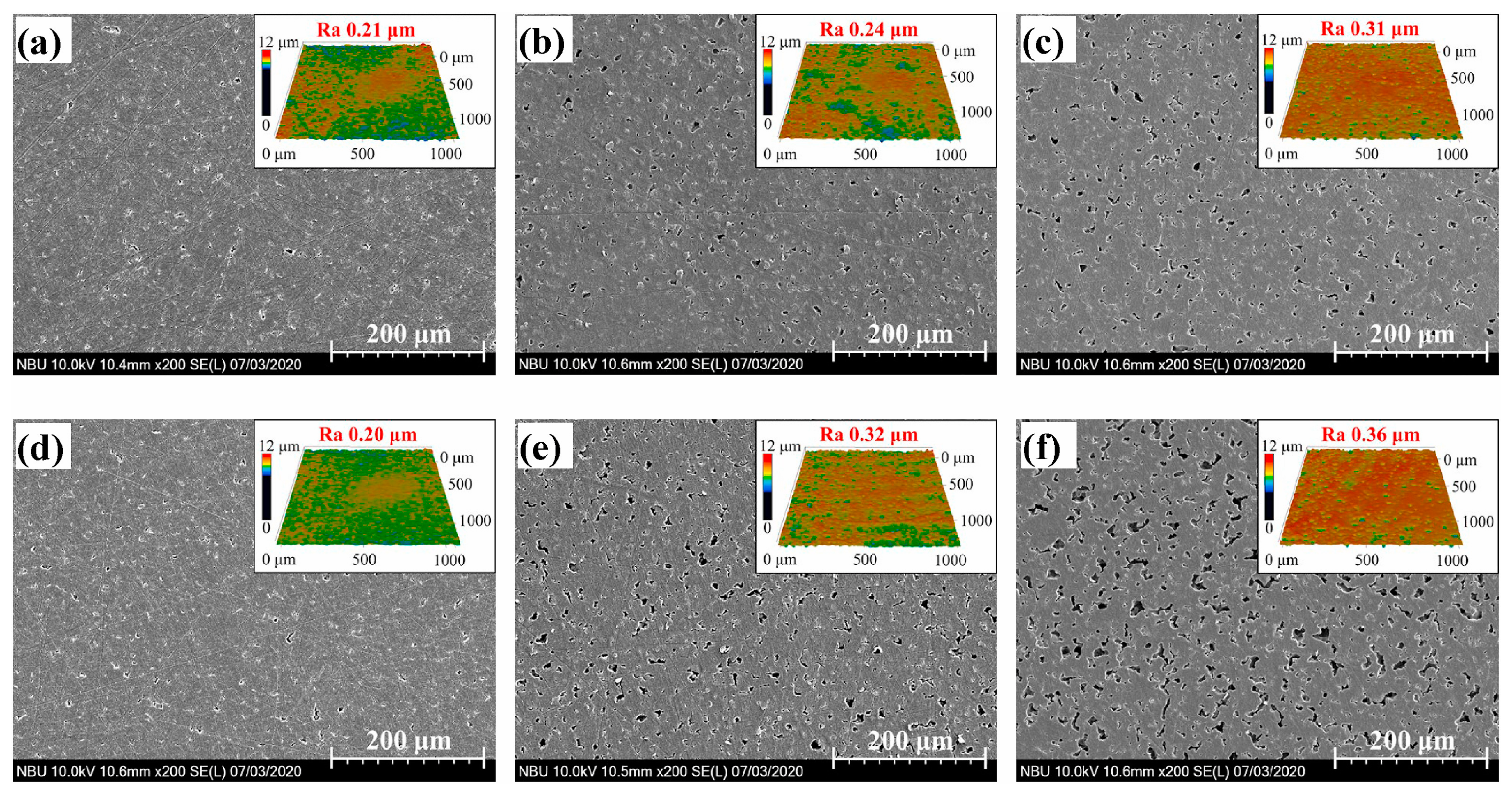

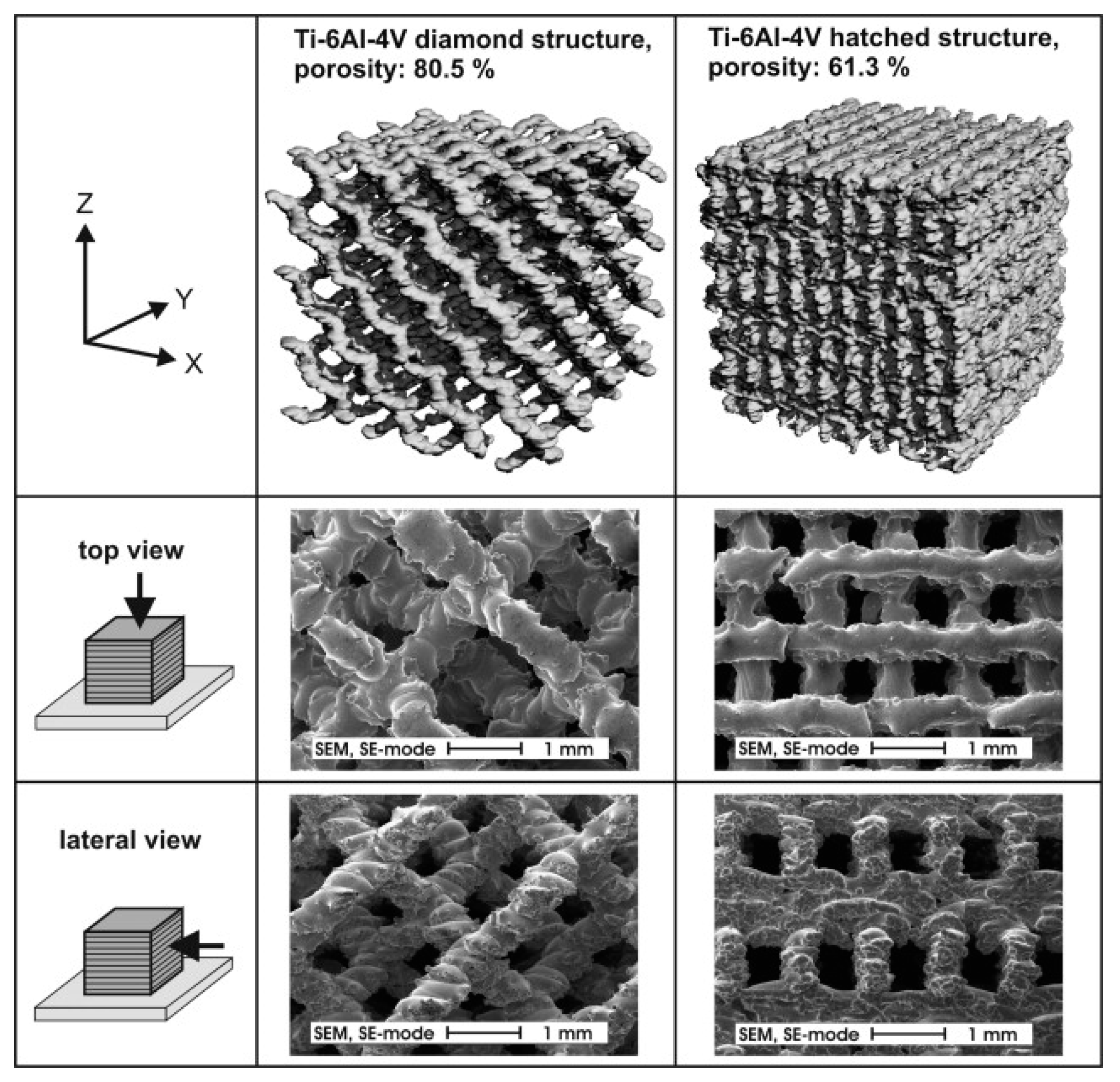
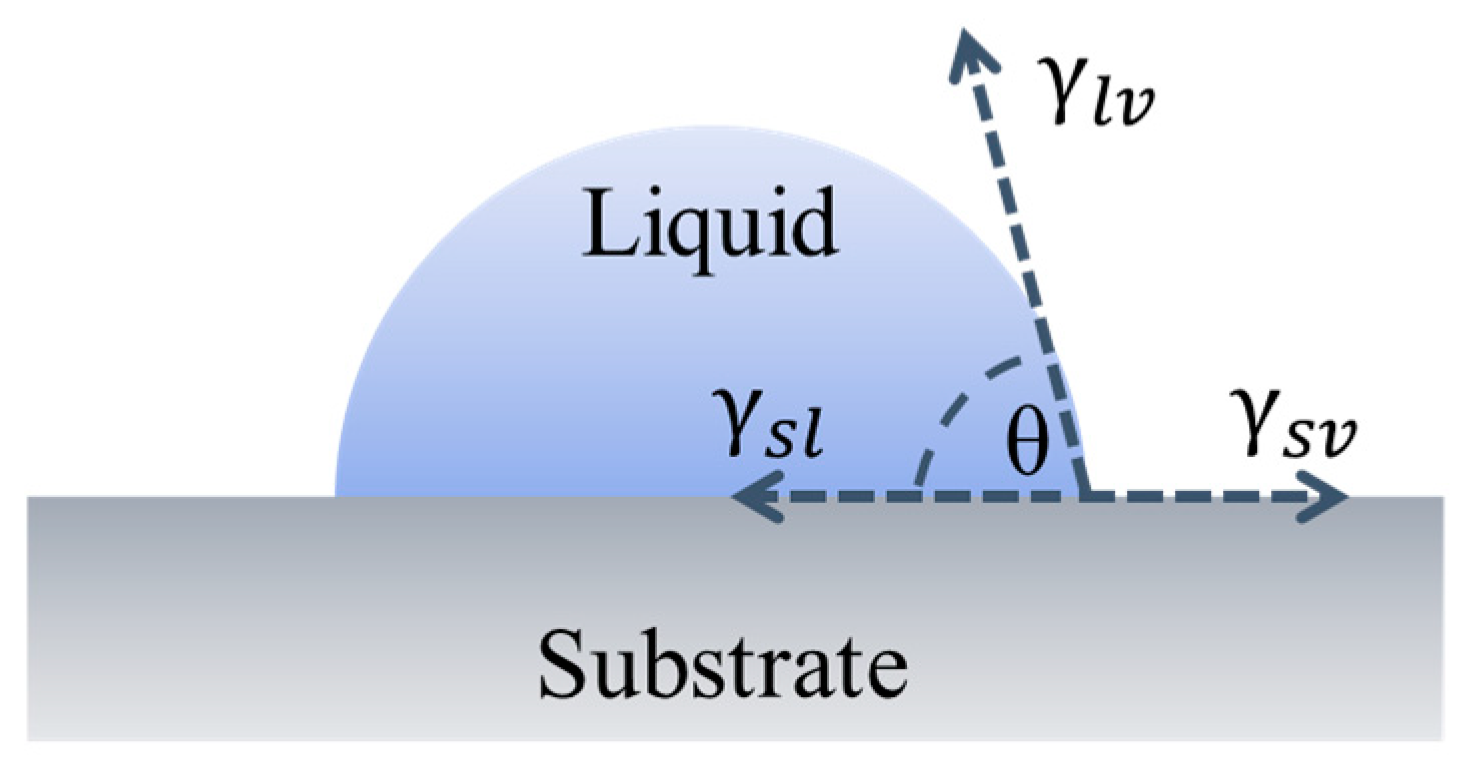
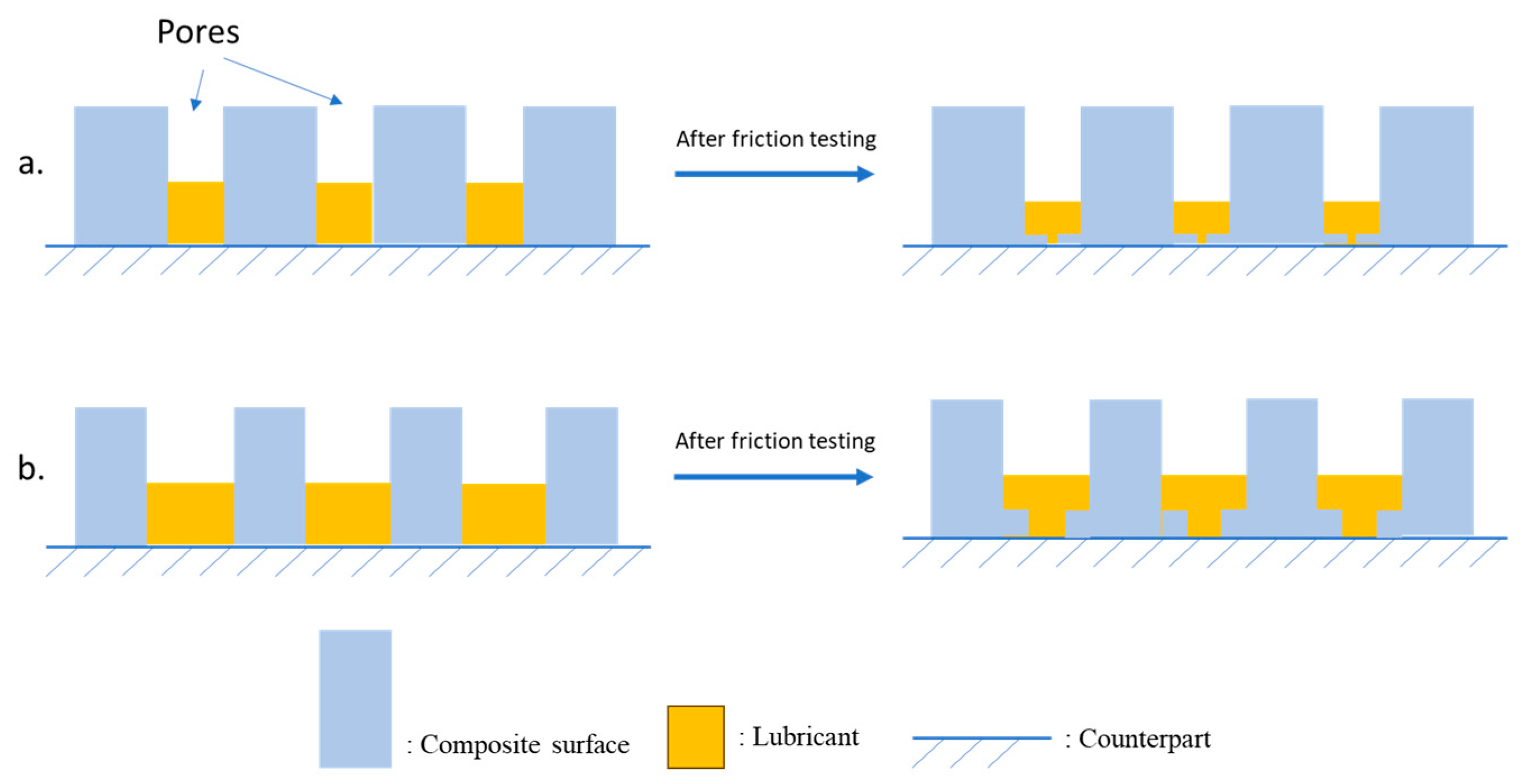
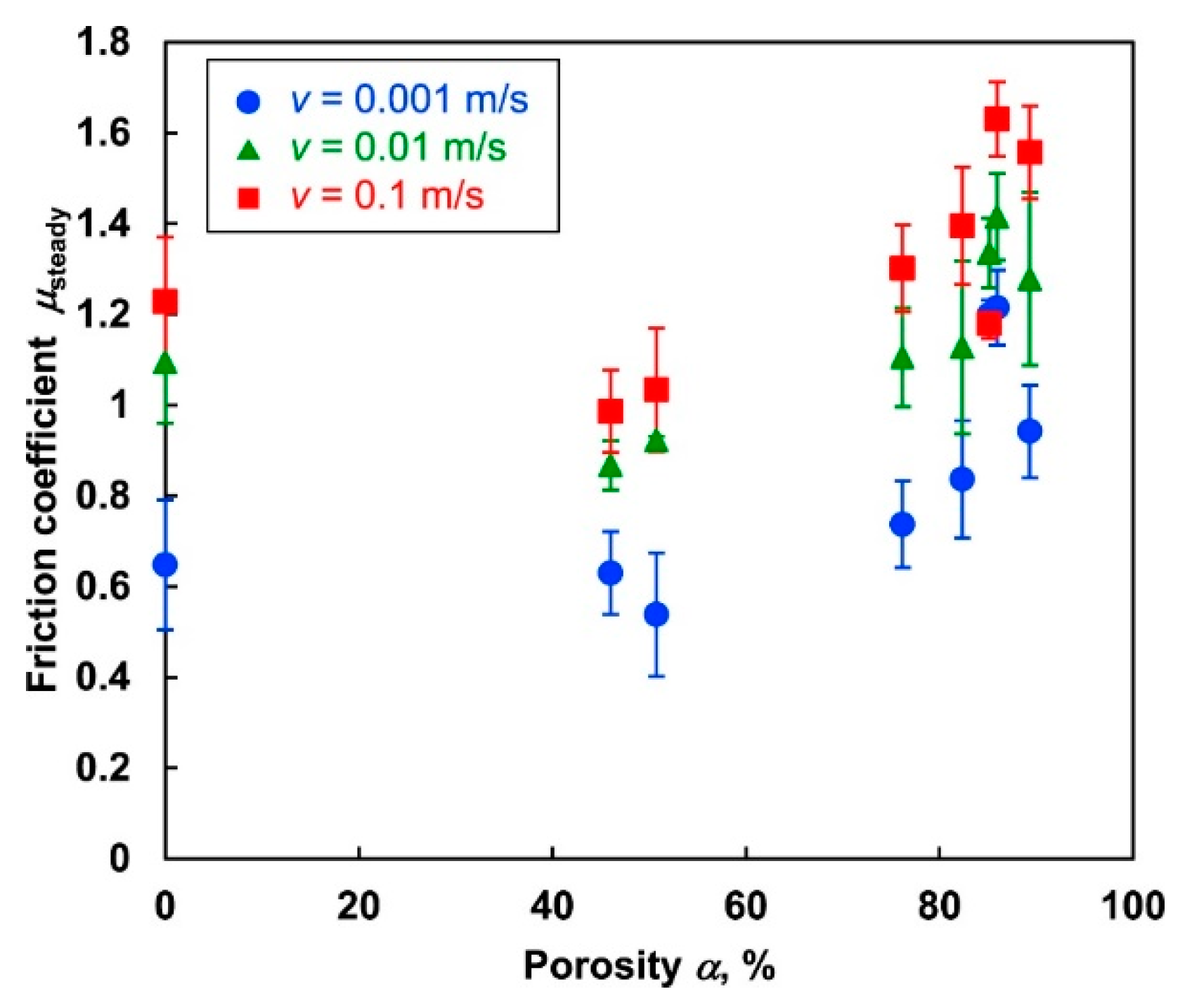
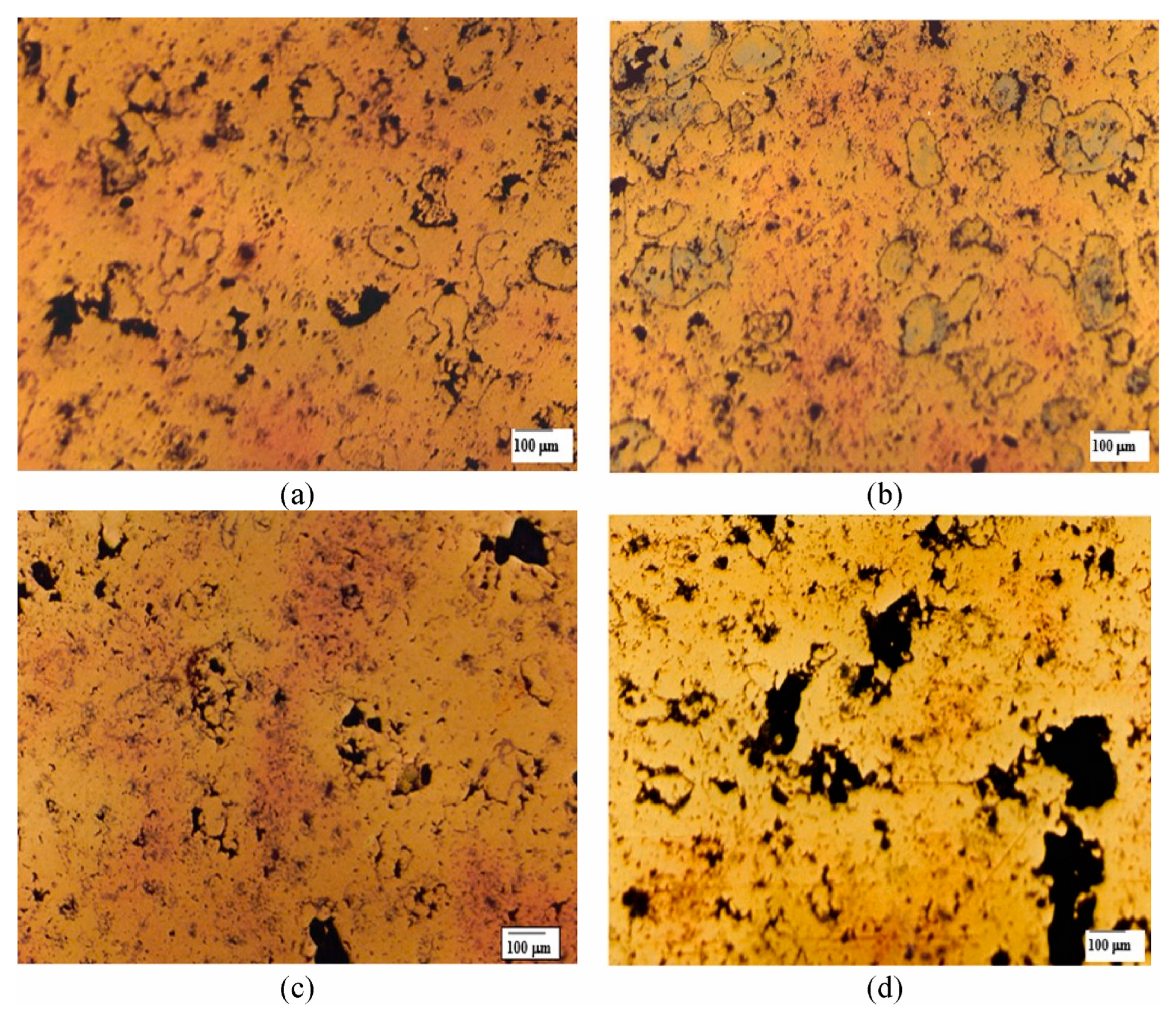

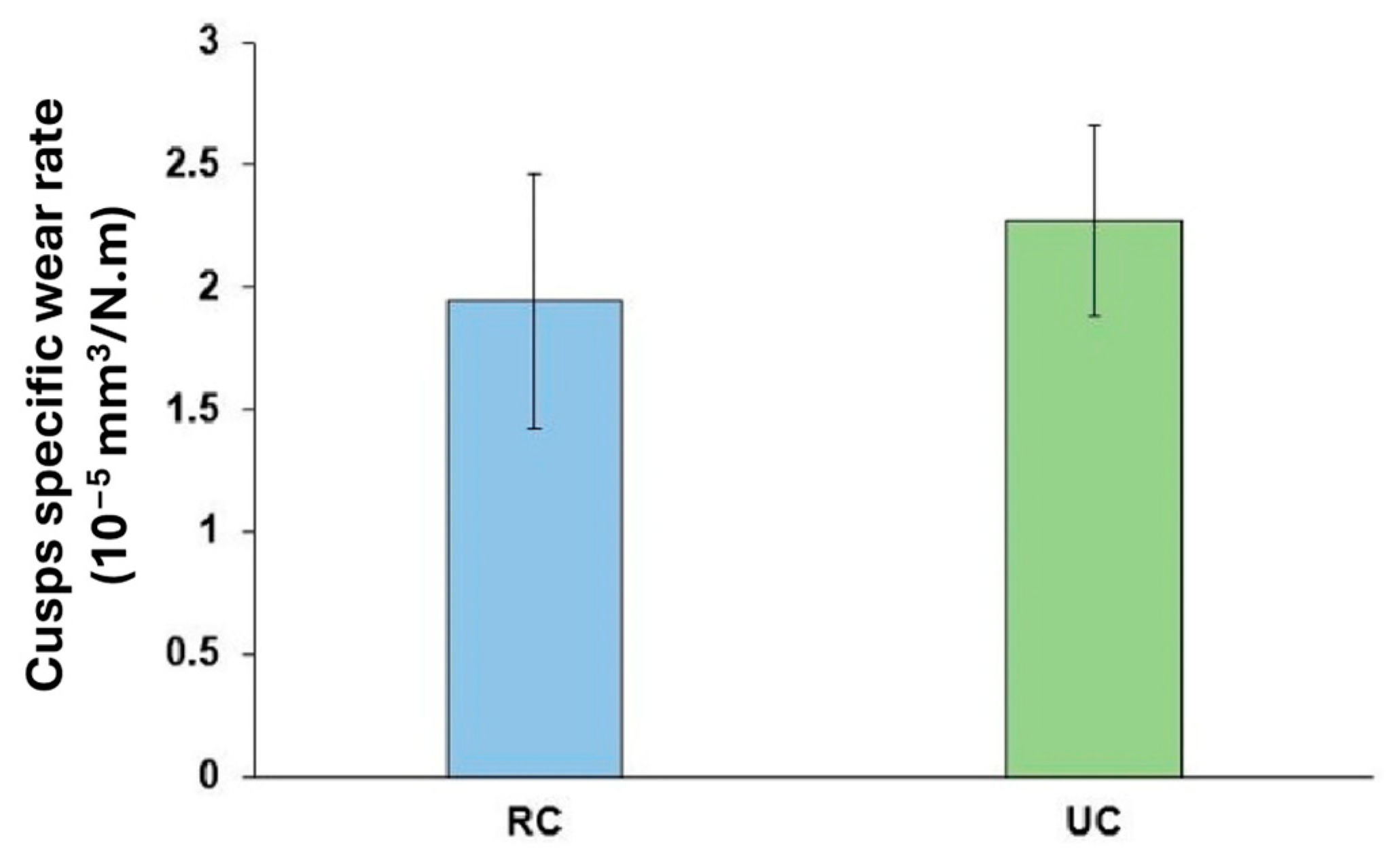
| Matrix | Lubricant and Impregnation Condition | Testing Condition | % COF and Wear | Ref. |
|---|---|---|---|---|
| Polyimide—20% porosity | Silicone oil (32 h at room temperature in vacuum) | Reciprocating sliding test against GCr15 steel ball at 20 N | COF = 0.03 (~10 times lesser than that of dry non-porous polyimide) | [11] |
| Polyphenylene sulfide (PPS) + PTFE with TiO2 whisker | Lithium-based grease (2 h at 120 °C in vacuum) | Wear resistance improved by 6.45 × 103 times compared with pure PPS | [21] | |
| PPS with 1% zeolite (20% porosity) | Lithium grease (2 h at 120 °C in vacuum) | Ring-on-ring test at 150 N with 1.4 m/s | COF = 0.024 and 1.79 × 10−16 m3/Nm (COF and wear were 90% and 4.67 × 104 lesser compared with dry PPS, respectively) | [15] |
| Polyimide (PPI) with 33.5% porosity | Diesel engine oil (12 h at room temperature in vacuum) | Ring-on-disk setup at 100 N and 0.22 m/s against stainless steel ring | COF = 0.1 (70% lesser than dry porous PI) | [18] |
| PEEK (16.8% porosity) | Ionic liquid: 1-butyl-3-methylimidazolium hexafluorophosphate (2 h at 80 °C in vacuum) | Ring-on-ring setup at 250 N and 0.69 m/s against 1045 steel ring | COF = 0.05 and wear rate 2.0 × 10−14 m3/Nm (COF and wear rate were 65% and 103 and were lower) | [61] |
| PPI (17.48%) | poly-α-olefin oil (20 h at 100 °C in vacuum) | Ball-on-disk (GCr15 steel ball) at 10 N and 0.2 m/s | PPI sample with the smallest pore diameter (1.48 μm) yielded the lowest COF ~0.035 | [25] |
Disclaimer/Publisher’s Note: The statements, opinions and data contained in all publications are solely those of the individual author(s) and contributor(s) and not of MDPI and/or the editor(s). MDPI and/or the editor(s) disclaim responsibility for any injury to people or property resulting from any ideas, methods, instructions or products referred to in the content. |
© 2024 by the authors. Licensee MDPI, Basel, Switzerland. This article is an open access article distributed under the terms and conditions of the Creative Commons Attribution (CC BY) license (https://creativecommons.org/licenses/by/4.0/).
Share and Cite
Kasar, A.K.; Jose, S.A.; D’Souza, B.; Menezes, P.L. Fabrication and Tribological Performance of Self-Lubricating Porous Materials and Composites: A Review. Materials 2024, 17, 3448. https://doi.org/10.3390/ma17143448
Kasar AK, Jose SA, D’Souza B, Menezes PL. Fabrication and Tribological Performance of Self-Lubricating Porous Materials and Composites: A Review. Materials. 2024; 17(14):3448. https://doi.org/10.3390/ma17143448
Chicago/Turabian StyleKasar, Ashish K., Subin Antony Jose, Brian D’Souza, and Pradeep L. Menezes. 2024. "Fabrication and Tribological Performance of Self-Lubricating Porous Materials and Composites: A Review" Materials 17, no. 14: 3448. https://doi.org/10.3390/ma17143448






